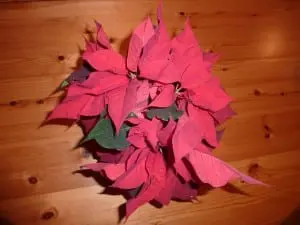By Pamela Doan
Holiday plants leave me feeling sad. Fleeting, holiday specific, and disposable once the season is past. Although I love them as décor, tossing them out in January or February feels like a waste. I have a hard time killing a plant deliberately just to get it out of the house, but where would the Valentine’s Day roses go? Or the Easter tulips and spring lilies? Sacrifices must be made. Or not. If you’re looking for an ongoing relationship with your holiday plants, here are some tips for extending the life of some of the most popular.

Poinsettias are especially difficult for me to dispose of after the holidays. Although their graceful hues symbolize the season more so than any other for me, making them last past January requires precise care and maintenance. If only I lived in Mexico, where poinsettia grow natively to be 10-foot shrubs, then it would be a joy to have them around, but here in Philipstown, not so practical.
In order to get their colorful leaves – bracts, not actual flowers – poinsettia need long nights. At least five days with 12 hours of darkness, putting them in the category of “short day” plants. You’ll have to keep this in mind before committing to maintaining a poinsettia. Into early spring, the poinsettia will keep its colors and more shoots will appear. It will flower on new growth next winter, so cut back the old flowering stems to 4-6 inches and shape the plant as you prune, leaving a few leaves on each stem. Feed it with a houseplant fertilizer twice a month.
Over the summer, the poinsettia can be repotted to a larger pot or put in the ground outside in a warm, sunny location. Keep it well watered. Bring it inside again in September well before the first frost. The plant must be kept in total darkness from 5 p.m. to 8 a.m. every day for about 10 weeks at a temperature between 60 and 70 degrees for it to flower again. This dormant period ends when you start to see the colorful bracts again and then it’s ready to be moved back into the warmth and light.
Amaryllis, a bulb, is an easy to grow and showy plant with dramatic flowers. At this time of year, amaryllis can be found at many stores, florists and garden centers pre-potted and ready to bloom. Ranging in price anywhere from $10 to $75, these kits don’t take much thought or care to set up. Remove from the box and follow the instructions, basically. An alternative is to purchase your own bulbs from an online nursery and pot your own with a bare root bulb. Since this is another tropical favorite, you can’t plant it outside and expect it to survive in our zone.
To save your amaryllis from the compost pile after it’s done blooming, cut back the stalks to about 2 inches from the top of the bulb. It’s going to need to replenish its food reserves and have a dormant period before next winter in order to bloom again. Give it a standard houseplant fertilizer once a month through the summer.
It can be planted outside in June in full sun, but you’ll have to dig it up again in September and re-pot it. At the end of September, place the pot in a cool, dark location and stop watering it to trigger a dormant period. It needs eight to 10 weeks of dormancy to produce those wonderful blooms again. Fifty to 55 degrees is best, let the foliage wither and cut it off. Mark the calendar, and after 10 weeks, bring it back into the warmth and light and start watering it again. Wait to see your efforts pay off with gorgeous stalks of two to four blooms again.
Finally, narcissus or paperwhites are in the daffodil family and will bloom through the darkest days of winter, brightening up inner rooms. White Flower Farms online growing guide had a great suggestion to buy a couple dozen bulbs and stagger planting them at intervals for an ongoing display of color. Paperwhites require little more than soil and water to bloom, making them the least sensitive to temperature and light out of the three and the easiest to successfully grow. However, these bulbs won’t bloom again, it’s a one-time deal. Add them to the compost pile when they’re finished with their show.

